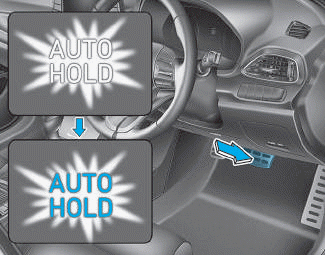Hyundai i-30: Braking system / AUTO HOLD
The Auto Hold maintains the vehicle in a standstill even though the brake pedal is not depressed, after the driver brings the vehicle to a complete stop by depressing the brake pedal.
To apply :

1. With the driver's door, engine bonnet and tailgate closed, fasten the driver's seat belt or depress the brake pedal and then press the [AUTO HOLD] switch. The white AUTO HOLD indicator will come on and the system will be in the standby position.

2. When you stop the vehicle completely by depressing the brake pedal, the Auto Hold maintains the brake pressure to hold the vehicle stationary. The indicator changes from white to green.
3. The vehicle will remain stationary even if you release the brake pedal.
4. If EPB is applied, Auto Hold will be released.
To release :
- If you press the accelerator pedal with the shift lever in D (Drive), R (Reverse) or manual shift mode, the Auto Hold will be released automatically and the vehicle will start to move. The AUTO HOLD indicator changes from green to white.
- If the vehicle is restarted using the cruise control toggle switch (RES+ or SET-) whilst Auto Hold and cruise control is operating, the Auto Hold will be released regardless of accelerator pedal operation. The AUTO HOLD indicator changes from green to white. (if equipped with cruise control system)
WARNING
When the AUTO HOLD is automatically released by depressing the accelerator pedal, always take a look around your vehicle. Slowly depress the accelerator pedal for a smooth start.
To cancel :

1. Depress the brake pedal.
2. Press the [AUTO HOLD] switch.
The AUTO HOLD indicator will turn off.
WARNING
To prevent, unexpected and sudden vehicle movement, ALWAYS press your foot on the brake pedal to cancel the Auto Hold before you:
- Drive downhill.
- Drive the vehicle in R (Reverse).
- Park the vehicle.
Information
- Auto Hold does not operate when:
- The driver's seat belt is unfastened and driver's door is opened
- The engine bonnet is opened
- The shift lever is in P (Park) or R (Reverse)
- The EPB is applied - For your safety, Auto Hold automatically
switches to EPB when:
- The driver's seat belt is unfastened and the driver's door is opened
- The engine bonnet is opened with the shift lever in D (Drive)
- The vehicle stops for more than 10 minutes
- The vehicle stands on a steep slope
- The vehicle moves several times In these cases, the parking brake warning light comes on, the AUTO HOLD indicator changes from green to white, and a warning sound and a message will appear to inform you that EPB has been automatically engaged. Before driving off again, press the foot brake pedal, check the surrounding area near your vehicle and release the parking brake manually with the EPB switch. - Whilst Auto Hold is operating, you may hear mechanical noise. However, it is normal operating noise.
NOTICE
If the AUTO HOLD indicator changes to yellow, the Auto Hold is not working properly.We recommend that you contact a HYUNDAI authorised repairer.
WARNING
- Depress the accelerator pedal slowly when you start the vehicle.
- For your safety, cancel the Auto Hold when you drive downhill, back up the vehicle or park the vehicle.
NOTICE
If there is a malfunction with the driver's door or engine bonnet open detection system, the Auto Hold may not work properly.
We recommend that you contact a HYUNDAI authorised repairer.
 Emergency braking
Emergency braking
If there is a problem with the brake
pedal whilst driving, emergency
braking is possible by pulling up and
holding the EPB switch. Braking is
possible only whilst you are holding
the EPB switch...
 Warning messages
Warning messages
Parking brake automatically locked
When the EPB is applied from Auto
Hold, a warning will sound and a
message will appear.
AUTO HOLD deactivating...
Other information:
Hyundai i30 (PD) 2018-2025 Service Manual: Components and components location
Component Location 1. Smart key unit (SMK) 2. Body control module (BCM) 3. Interior antenna 1 4. Interior antenna 2 5. FOB key 6. Start Stop Button (SSB) 7. Door handle & door antenna 8...
Hyundai i30 (PD) 2018-2025 Owner's Manual: Jack and tools
(1) Jack handle (2) Jack (3) Wheel nut wrench The jack, jack handle, and wheel nut wrench are stored in the luggage compartment under the luggage box cover. The jack is provided for emergency tyre changing only. Turn the winged hold down bolt counterclockwise to remove the spare tyre...
Categories
- Manuals Home
- 3rd Generation i30 Owners Manual
- 3rd Generation i30 Service Manual
- Trip computer
- Light bulbs
- To activate the ISG system
- New on site
- Most important about car
Warning light and message

When the High Beam Assist (HBA)
System is not working properly, the
warning message will come on for a
few second. After the message disappears,
the master warning light ( )
will illuminate.
)
will illuminate.
